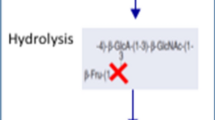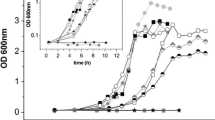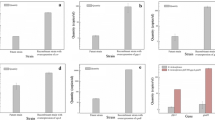Abstract
The production of industrially relevant microbial polysaccharides has recently gained much interest. The capsular polysaccharide of Escherichia coli K4 is almost identical to chondroitin, a commercially valuable biopolymer that is so far obtained from animal tissues entailing complex and expensive extraction procedures. In the present study, the production of capsular polysaccharide by E. coli K4 was investigated taking into consideration a potential industrial application. Strain physiology was first characterized in shake flask experiments to determine the optimal culture conditions for the growth of the microorganism and correlate it to polysaccharide production. Results show that the concentration of carbon source greatly affects polysaccharide production, while the complex nitrogen source is mainly responsible for the build up of biomass. Small-scale batch processes were performed to further evaluate the effect of the initial carbon source concentration and of growth temperatures on polysaccharide production, finally leading to the establishment of the medium to use in following fermentation experiments on a bigger scale. The fed-batch strategy next developed on a 2-L reactor resulted in a maximum cell density of 56 gcww/L and a titre of capsular polysaccharide equal to 1.4 g/L, approximately ten- and fivefold higher than results obtained in shake flask and 2-L batch experiments, respectively. The release kinetics of K4 polysaccharide into the medium were also explored to gain insight into the mechanisms underlying a complex aspect of the strain physiology.




Similar content being viewed by others
References
Bliss JM, Silver RP (1996) Coating the surface: a model for expression of capsular polysialic acid in Escherichia coli K1. Mol Microbiol 21:221–231
Bradford MM (1976) A rapid and sensitive method for the quantification of microgram quantities of protein utilizing the principle of protein dye binding. Anal Biochem 72:248–254
Chong BF, Blank LM, Mclaughlin R, Nielsen LK (2005) Microbial hyaluronic acid production. Appl Microbiol Biotechnol 66:341–351. doi:10.1007/s00253-004-1774-4
Cutayar JM, Poillon D (1989) High cell-density culture of Escherichia coli in a fed-batch system with dissolved oxygen as substrate feed indicator. Biotechnol Lett 11:155–160
Gonçalves VM, Zangirolami TC, Giordano RL, Raw I, Tanizaki MM, Giordano RC (2002) Optimization of medium and cultivation conditions for capsular polysaccharide production by Streptococcus pneumoniae serotype 23F. Appl Microbiol Biotechnol 59(6):713–717. doi:10.1007/s00253-002-1075-8
Jang H, Yoon YK, Kim JA, Kim HS, An SJ, Seo JH, Cui C, Carbis R (2008) Optimization of Vi capsular polysaccharide production during growth of Salmonella enterica serotype Typhi Ty2 in a bioreactor. J Biotechnol 135(1):71–77. doi:10.1016/j.jbiotec.2008.02.017
Kim BS, Lee SC, Lee SY, Chang YK, Chang HN (2004) High cell density fed-batch cultivation of Escherichia coli using exponential feeding combined with pH-stat. Bioprocess Biosyst Eng 26:147–150. doi:10.1007/s00449-003-0347-8
Kogan G, Šoltés L, Stern R, Gemeiner P (2007) Hyaluronic acid: a natural biopolymer with a broad range of biomedical and industrial applications. Biotechnol Lett 29(1):17–25. doi:10.1007/s10529-006-9219-z
Lee SY (1996) High cell-desity culture of Escherichia coli. Trends Biotechnol 14:98–105. doi:10.1016/0167-7799(96)80930-9
Lindahl U (2000) 'Heparin'—from anticoagulant drug into the new biology. Glycoconj J 17(7–9):597–605
Manzoni M, Bergomi S, Molinari F, Cavazzoni V (1996) Production and purification of an extracellularly produced K4 polysaccharide from Escherichia coli. Biotechnol Lett 18(4):383–386
Märkl H, Zenneck C, Dubach A, Ogbonna JC (1993) Cultivation of E. coli to high cell densities in a dialysis reactor. Appl Microbiol Biotechnol 39:48–52
McAlindon TE, LaValley MP, Gulin JP, Felson DT (2000) Glucosamine and chondroitin for treatment of osteoarthritis: a systematic quality assessment and meta-analysis. JAMA 283:1469–1475
Mellata M, Dho-Moulin M, Dozois CM, Curtiss R 3rd, Lehoux B, Fairbrother JM (2003) Role of avian pathogenic Escherichia coli virulence factors in bacterial interaction with chicken heterophils and macrophages. Infect Imm 71:494–503
Merrit B, Allard G, O’Toole L, Swartz R, Licari P (2000) Development and scale-up of a fed-batch process for the production of capsular polysaccharide from Haemophilus influenzae. J Biotech 81:189–197
Restaino OF, Cimini D, De Rosa M, De Castro C, Parrilli M, Schiraldi C (2009) High performance capillary electrophoresis analysis of Escherichia coli K4 cell surface polysaccharides: separation and determination of lipopolysaccharide and capsular polysaccharide species and of their respectively de-lipid A defructosylated forms. Electrophoresis.. doi:10.1002/elps.200900279
Roberts IS (2000) The expression of polysaccharide capsules in Escherichia coli: A molecular genetic perspective. In: Doyle R (ed) Glycomicrobiology. Kluwer, New York, pp 441–46. doi:10.1007/0-306-46821-2_15
Rode B, Endres C, Ran C, Stahl F, Beutel S, Kasper C, Galuska S, Geyer R, Mühlenhoff M, Gerardy-Schahn R, Scheper T (2008) Large-scale production and homogenous purification of long chain polysialic acids from E. coli K1. J Biotechnol 135(2):202–209. doi:10.1016/j.jbiotec.2008.03.012
Rodriguez ML, Jann B, Jann K (1988) Structure and serological characteristics of the capsular K4 antigen Escherichia coli O5:K4:H4, a fructose-containing polysaccharide with chondroitin backbone. Eur J Biochem 177:117–124
Volpi N (2006) Chondroitin sulfate: structure, role and pharmacological activity. Advances in pharmacology, vol. 53, Elsevier, Amsterdam
Westphal O, Jann K (1965) Bacterial lipopolysaccharides extraction with phenol water and further applications of the procedure. Methods Carbohydr Chem 5:83–92
Whitfield C, Roberts IS (1999) Structure, assembly and regulation of expression of capsules in Escherichia coli. Mol Microbiol 31:1307–1320
Acknowledgements
The research was supported by the Ministero dell’Istruzione dell’Università e della Ricerca (MIUR), L.297 project “Produzione biotecnologica di condroitina.” The authors gratefully acknowledge Prof. Parrilli and Dr. Cristina De Castro for the NMR analysis (Bioteknet–Department of Organic Chemistry and Biochemistry, University of Naples Federico II, Via Cinthia 4, 80126 Naples, Italy).
Author information
Authors and Affiliations
Corresponding author
Rights and permissions
About this article
Cite this article
Cimini, D., Restaino, O.F., Catapano, A. et al. Production of capsular polysaccharide from Escherichia coli K4 for biotechnological applications. Appl Microbiol Biotechnol 85, 1779–1787 (2010). https://doi.org/10.1007/s00253-009-2261-8
Received:
Revised:
Accepted:
Published:
Issue Date:
DOI: https://doi.org/10.1007/s00253-009-2261-8




